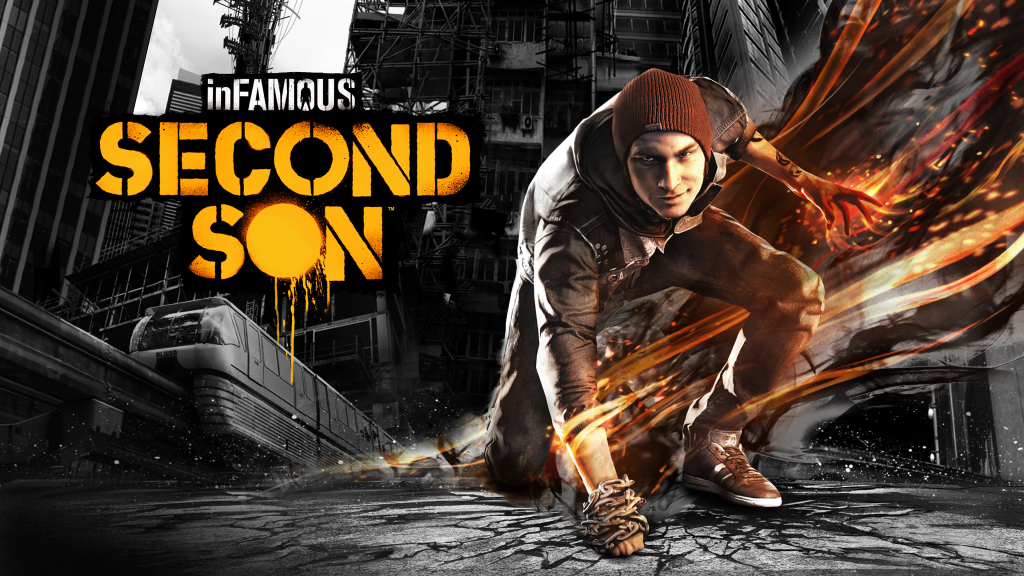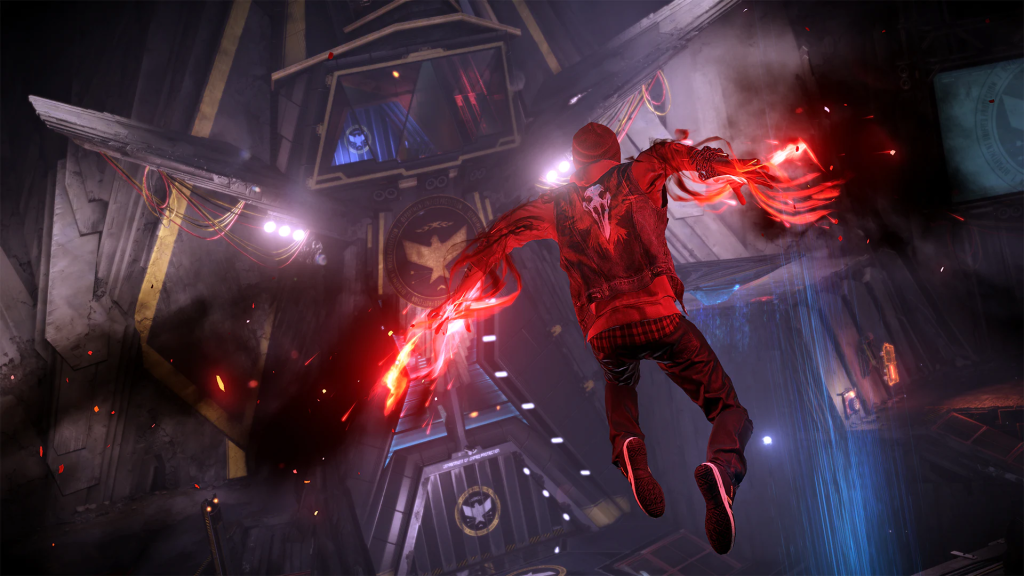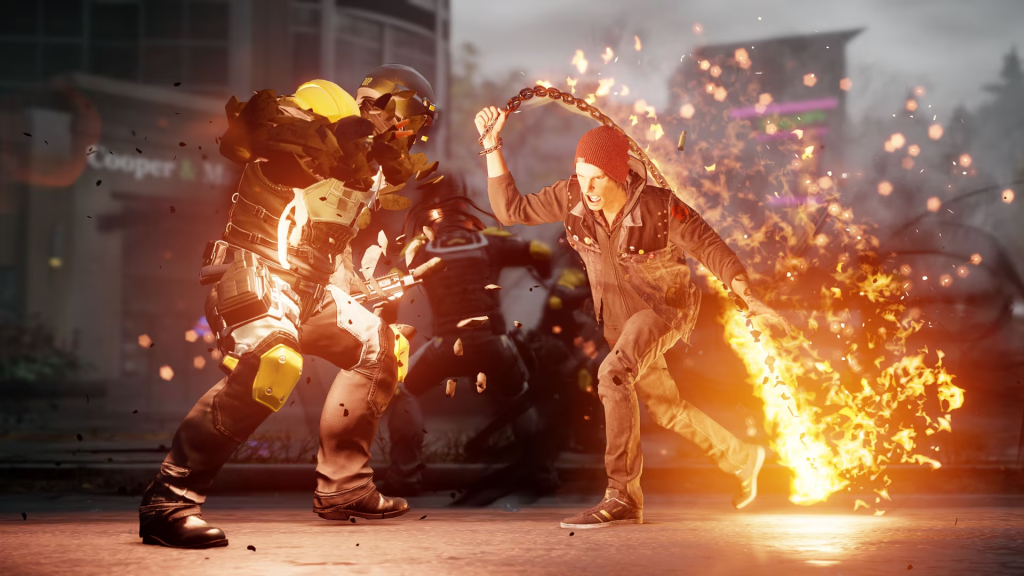
There are relatively few people with extraordinary powers left in the world seven years after the events described in the previous game. Bio-terrorists, they are pursued at every step by a special government group whose sole mission is to catch the mutant and defend regular folks from superhuman aggressiveness. These are dull times, especially if we swiftly rise from the ranks of an average, malicious graffiti artist to that of a bio-terrorist.
Delsin Rowe is a 24-year-old rebel with Native American ancestors. He observes the collision of an armored vehicle transporting three mutant detainees with Reggie, his elder brother and a law enforcement officer. One of the fugitives makes eye contact with the main character, who inexplicably “takes over” authority from the fugitive. Everything becomes more complex from this point on. Not only is his relationship with his brother jeopardized as a result of multiple acts of damage, but concealing his new skills leads to painful interrogations of the residents of the little village. The Department of Unified Defense, directed by the ruthless boss Augustine, cripples Delsin’s loved ones, prompting our hero to battle the authorities for justice and the healing of all those who have been harmed. The older brother joins the struggle and travels to Seattle, where the headquarters of the specified group is located. Despite the fact that the hero is extremely different from Cole from previous game – there is no link between them and previous events – Delsin instantly wins compassion due to the excellent performance. Troy Baker not only gave the appropriate voice, but also utilized his own face to recreate the facial emotions, resulting in a highly vibrant and genuine main character with numerous facial expressions.

The classic structure and relatively basic tale may be highly positive at times, owing to the two routes offered in the scenes: good and evil. We are frequently presented with a decision that influences our karma and subsequent events in the game. Even though there isn’t always a significant variation in the choices made, all of the scenes described may have a drastically different tone. NPCs may pick us up according on our actions; they may even entirely change their attitude, and passers-by will start rushing away in fright instead of being delighted to meet us. Very natural-looking sequences successfully “juggle” emotions, depending on the decisions made. Good actions give us a sense of accomplishment, but selfish decisions can leave us with bittersweet regret. Character movements and genuine face expressions boost empathy and add to the overall cinematic mood of the game. Seattle’s recreation was highly effective. It’s a wide open universe where we may move in whatever way we want. Its size is comparable to the cities in the previous sections. Each district has its own particular style and noteworthy buildings, such as the famed “space spire” that towers over the others. Beautiful light reflections and ambient music provide the sense of a live metropolis, and we frequently pause while running to observe the attractive location. It’s worth wandering along the street late at night, listening to music from a neighboring pub, watching the news on TVs in electronics stores, and even getting a taste of city life. The developers have concealed hilarious allusions to previous portions of the game and their other creations throughout the game, prompting us to navigate carefully.
The previously recognized divide of gameplay in inFamous between that based on karma, i.e. heroically altruistic and chaotic, returns in stunning fashion. We may either attempt not to kill the innocent and become a hero in Seattle’s eyes, or we can overlook the casualties and aggressively push our way to Augustine using fire, explosives, and encouraging crime. Some power enhancements even need a certain quantity of good or bad karma. Players who choose the good route must be cautious not to hurt civilians. As the tale unfolds, we come across additional tasks for both “red” and “blue” pathways. The first is to cause confusion and mayhem among locals by injuring innocent individuals, assaulting regular police personnel, or dispersing protesters. Blue actions focus on assisting the underprivileged and combating crime on Seattle’s streets. We dash, fly, and climb across city areas, gradually attaining superhuman smoke powers, reducing the strength of hostile organization units and seizing control in Seattle. Outside of the major plot tasks, we may engage in a variety of activities distributed around the area, as befits an open-world game. Delsin exploits his gift for painting rebellious drawings with spray paint, and he beautifully decorates the entire city at every chance, which we accomplish using an unusual mini-game. Other efforts are only intended to destabilize the administration and expand our authority.

Meanwhile, Seattle has transformed into a police state, complete with cameras, guard towers, checkpoints, and field jails. By destroying them all, the hostile regime’s control is weakened. The department’s black and yellow hues are visible everywhere and are begging to be demolished. One questionable move that may disclose our superpowers instantly raises the alarm among neighboring patrols, turning the city into a fight. All side missions and activities are entertaining, owing in part to superpowers, which add a lot of fun in the current installment. Beautiful visual effects strengthen the image, and we can truly feel Delsin’s might. Throwing projectiles from embers creates lovely trails in the air, and the effects of receiving energy from surrounding chimneys and bonfires are frequently enthralling. An large skill tree allows for a wide diversity of opponent behaviors. We may either rapidly incapacitate him or murder him in cold blood, damaging multiple structures and more fragile environmental aspects in the process. Delsin subsequently gains access to elements other than smoke. One of these is the power of neon lights, which, in addition to “smoke”-like assaults, allows you to briefly halt time and blast luminous lasers from a greater distance. The neon hero is also exceedingly fast and can run up tall walls. The mechanics of altering the power set are linked to the absorption of a certain “element,” and they operate flawlessly. We absorb smoke from the chimney while standing on the roof, toss fire bombs, and then drop down to the street, where we pull energy from a nearby neon sign and can now discharge lasers from our hands. All of the essential energy sources are well thought out and readily available if we know where to search – including in most boss encounters.
Delsin’s opponents might also favorably surprise him. In addition to rank-and-file troops armed with firearms, the Department of Unified Defense contains personnel with tangible authority. Some guards strengthen their armor as a result of this, while others shield their comrades by erecting stone curtains, and yet others bounce all over the place by “shooting” from concrete platforms. Our hero appears to be not the only one who enjoys experimenting with his skills; as a result, even the tiniest squabble might grow into an exciting fight. Fights with larger foes and bosses aren’t challenging, but they are varied and need mastery of all possible superpowers. The last two story missions just seem to fly by, and I wish the last fights were a little longer. A casual go through of the game can take up to 10 hours. Meanwhile, those who want to accomplish every side mission and acquire all the goods while still keeping an eye out for civilians will have 20 to 30 hours of enjoyment. The shift in the storyline induced by bad or excellent decisions is also so intriguing that you want to repeat the game immediately after completing one route to see how the tale develops in the second path. Additional missions, which will occur on a regular basis beginning with the premiere, will most likely entice you to return to Seattle to solve a few more mutant-related riddles.
The journey in inFamous: Second Son does not disappoint and retains the quality of the series’ prior installments. The next console generation provides an excellent chance to offer improved visual effects, enhance mechanics, and even tell the narrative of a brand new hero in an already familiar universe. But it is undeniably the same wonderful inFamous. The story, which is somewhat comedic in style and storyline – “from zero to superhero” – is as ancient as time, yet it is not at all boring and may be a lot of fun.
